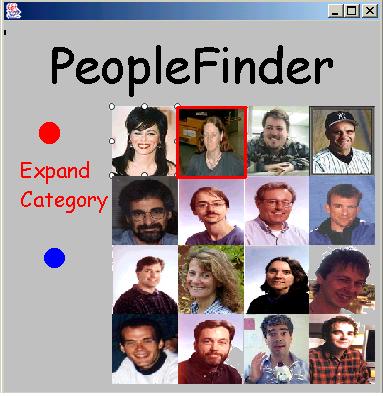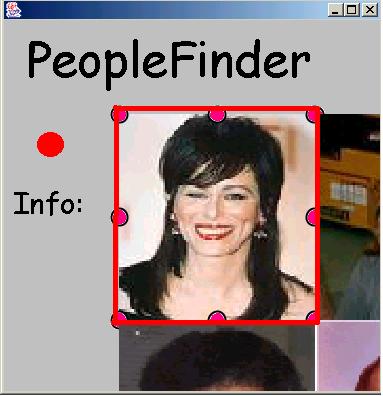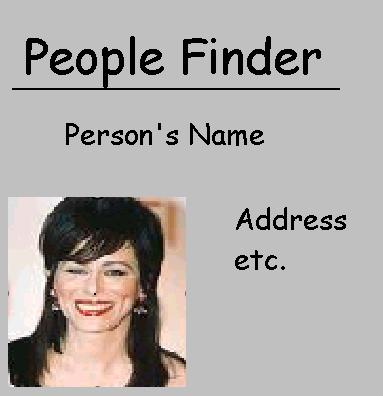Project Proposal: PeopleFinder
CS533 Information Visualization
Rhian Davies
davies@cs.ubc.ca
February 13, 2003
Domain and Task Description:
Traditionally, searching through images has required that the image filename be known; this is also true of searching for people in a database. However, if the file, image, or person's name is not known, it becomes necessary to conduct a serial search through all the images until the one image is found. This problem is most acute for those with aphasia, an acquired language disorder that results from damage to the language areas of the brain. However, an aging population is also susceptible to memory loss, with the resulting inability to access electronic databases through text based identifiers alone.
This project aims to address this problem by creating a way for a user to navigate through images of people quickly, allowing the user to find a person without requiring the name of the person to be used.
PeopleFinder ties in with the Aphasia Project, a multidisciplinary project currently working on researching and developing applications for people with aphasia. I am currently learning more about aphasia through a course I am taking in the Speech Sciences Department, and through involvement with the Aphasia Project.
Motivation:
The choice of project was inspired by both the problem of loosing names experienced by people with aphasia, and by PhotoMesa, software developed at the University of Maryland to search through images in a directory. Unfortunately, the source code is not available; however, the idea of scanning a large number of thumbnails combined with the ability to zoom in on a subset is one that could easily be applied to the PeopleFinder project.
Proposed Implementation:
PeopleFinder will be implemented in Java, using Piccolo, a toolkit that supports zoomable user interfaces (ZUI).
Scenario of Use:
This system could be used in conjunction with other applications developed for people with aphasia, for example a day planner. An appointment in a day planner would include an image of the person the user was meeting. A quick and efficient way of retrieving images of people is therefore necessary. This project will address this need. Although a database of images would be time consuming to develop, if the day planner is sufficiently useful, the user would have the motivation to create such a database.
 Individuals will represent broader categories that can be expanded; for example one person in the initial display would represent all the individuals in one category. This will allow the PeopleFinder to start with a smaller subset of people than that which exists in the database.
During the project, different ways to reduce the search space will be explored.
Individuals will represent broader categories that can be expanded; for example one person in the initial display would represent all the individuals in one category. This will allow the PeopleFinder to start with a smaller subset of people than that which exists in the database.
During the project, different ways to reduce the search space will be explored.
 The interface will allow users to either expand the category associated with an image, or zoom in on an image. Once one image has been selected, an option will be given allowing the user to access and view the selected individuals information.
The interface will allow users to either expand the category associated with an image, or zoom in on an image. Once one image has been selected, an option will be given allowing the user to access and view the selected individuals information.

 Individuals will represent broader categories that can be expanded; for example one person in the initial display would represent all the individuals in one category. This will allow the PeopleFinder to start with a smaller subset of people than that which exists in the database.
During the project, different ways to reduce the search space will be explored.
Individuals will represent broader categories that can be expanded; for example one person in the initial display would represent all the individuals in one category. This will allow the PeopleFinder to start with a smaller subset of people than that which exists in the database.
During the project, different ways to reduce the search space will be explored.
 The interface will allow users to either expand the category associated with an image, or zoom in on an image. Once one image has been selected, an option will be given allowing the user to access and view the selected individuals information.
The interface will allow users to either expand the category associated with an image, or zoom in on an image. Once one image has been selected, an option will be given allowing the user to access and view the selected individuals information.
